Practice Free PL-400 Exam Online Questions
Note: This question is part of a series of questions that present the same scenario. Each question in the series contains a unique solution that might meet the stated goals. Some question sets might have more than one correct solution, while others might not have a correct solution.
After you answer a question in this section, you will NOT be able to return to it. As a result, these questions will not appear in the review screen.
An organization has an Azure SQL Database instance that must be synchronized daily with data from Dynamics 365 Sales. A large amount of data might need to be synchronized on some days.
You need to reduce the time required to synchronize data.
Solution:
Enable change tracking for entities that will be synchronized.
Use the Data Export Service to sync data between the database and Dynamics 365 Sales.
Does the solution meet the goal?
- A . Yes
- B . No
A
Explanation:
Large organizations that synchronize their data with external data sources can now enable entities for change tracking. You can export or retrieve a selected set of data, and then keep the external data warehouse in sync.
The Data Export Service is an add-on service made available on Microsoft AppSource that adds the ability to replicate data from Common Data Service database to an Azure SQL Database store in a customer-owned Azure subscription.
The Data Export Service intelligently synchronizes the entire data initially and thereafter synchronizes on a continuous basis as changes occur (delta changes) in the system.
You can use the Data Export Service with model-driven apps in Dynamics 365, such as Dynamics 365 Sales and Dynamics 365 Customer Service.
Reference:
https://docs.microsoft.com/en-us/power-platform/admin/enable-change-tracking-control-data-synchronization
https://docs.microsoft.com/en-us/power-platform/admin/replicate-data-microsoft-azure-sql-database
Note: This question is part of a series of questions that present the same scenario. Each question in the series contains a unique solution that might meet the stated goals. Some question sets might have more than once correct solution, while others might not have a correct solution.
After you answer a question in this section, you will NOT be able to return to it. As a result, these questions will not appear in the review screen.
You are designing a one-way integration from the Common Data Service to another system.
You must use an Azure Function to update the other system. The integration must send only newly created records to the other system. The solution must support scenarios where a component of the integration is unavailable for more than a few seconds to avoid data loss. You need to design the integration solution.
Solution: Register a service endpoint in the Common Data Service that connects to an Azure Service Bus queue.
Register a step at the endpoint which runs asynchronously on the record’s Create message and in the portoperation stage.
Configure the Azure Function to process records as they are added to the queue.
Does the solution meet the goal?
- A . Yes
- B . No
A
Explanation:
Microsoft Dataverse supports integration with Azure.
For the Dataverse and Azure connection to work, there must be at least one solution in an Azure Service Bus solution account, where the solution contains one or more service endpoints. For a queue endpoint contract, a listener doesn’t have to be actively listening.
Reference: https://docs.microsoft.com/en-us/powerapps/developer/common-data-service/azure-integration
Which permissions does a managed identity have on Microsoft Dataverse data?
- A . permissions assigned to the corresponding application user
- B . permissions assigned to the user triggering the Azure resource
- C . permissions equivalent to the environment admin role
- D . permissions equivalent to the system administrator role
You plan to populate records in a Common Data Service entity containing an option set field.
The source system has the label for the option set but not the corresponding integer value.
You are using a non .NET programming language.
You need to find the integer value for the option set.
What should you do?
- A . Use Web API and use a PicklistAttibuteMetadata request.
- B . Use the Organization service and execute a RetrieveOptionSetRequest request.
- C . Use Web API and use an InsertOptionValue action.
- D . Use the Organization service and execute a RetrieveAttributeRequest request.
B
Explanation:
You can retrieve a global choice (option set) by name (label) using the RetrieveOptionSetRequest message.
Reference: https://docs.microsoft.com/en-us/powerapps/developer/data-platform/org-service/metadata-option-sets
A client uses a model-driven app that is deployed by using a managed solution in the production environment. The app contains only entities and UI components and has no custom code or extensions to the platform.
The client needs an exact copy of the app with a different name in the production environment.
You need to recreate this app in production without disrupting the end users.
What should you do?
- A . Select the original model-driven app, select Edit, and then select Save As.
- B . Create a new model-driven app. Select the Use existing solution to create the App check box, and then select the solution that contains the original app.
- C . Select the managed solution and select Clone.
- D . Create a new model-driven app, manually add each component, and then recreate its original functions.
- E . Add the original app to a solution, export it as unmanaged, import it into a test environment and rename it, and then deploy it back into production.
B
Explanation:
The option Use existing solution allow users to select a specific solution for this app. Users can create a whole new design from scratch by not checking check box of use existing solution.
Reference: https://www.inogic.com/blog/2019/02/create-model-driven-app-cds-environment/
HOTSPOT
A company has a development environment and a production environment. The production environment has several third-party managed and unmanaged solutions that made changes to the Contact main form.
You create a new solution in the development environment. You add the Contact entity and the Contact main form to the solution. You create a custom field on the Contact entity.
What happens when you perform these actions and import the solution into the production environment? To answer, select the appropriate options in the answer area. NOTE: Each correct selection is worth one point.
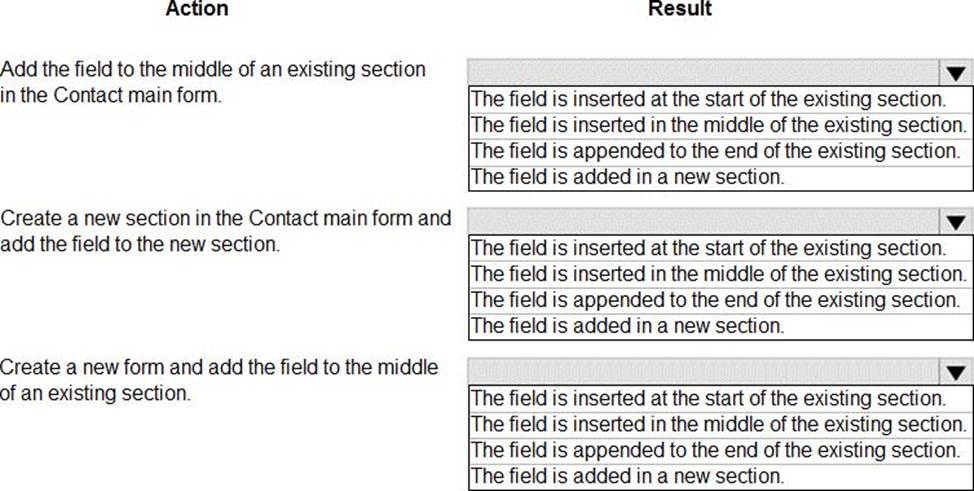
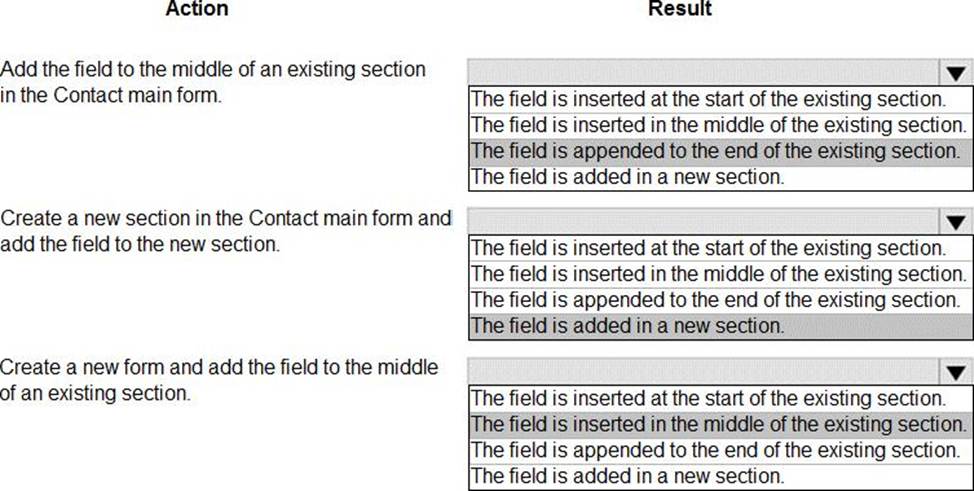
Explanation:
Box 1: The field is appended to the end of the existing section.
When you add new elements to a form that is to be merged, we recommend that you include your new elements within new container elements (tabs or sections). Additions to any container will be appended to the end of the container. For example, fields added to a section will be positioned at the end of the section.
Box 2: The field is added in a new section.
Box 3: The field is inserted in the middle of the existing section
Reference: https://docs.microsoft.com/en-us/previous-versions/dynamicscrm-2016/developers-guide/gg309329(v=crm.8)
You are creating a plug-in for an app that helps government employees get a proof of vaccination card.
You must add the following information to a vaccination record before a proof of vaccination card is created:
• Vaccination type
• Date of vaccination
• Name of person administering the vaccine You need to register the plug-in.
In which stage should you register the plug-in?
- A . PreOperation
- B . MainOperation
- C . PreValidation
- D . PostOperation
DRAG DROP
You need to assign security roles to groups of users.
Which security roles should you use? To answer, drag the appropriate security types to the correct roles. Each security type may be used once, more than once, or not at all. You may need to drag the split bar between panes or scroll to view content. NOTE: Each correct selection is worth one point.
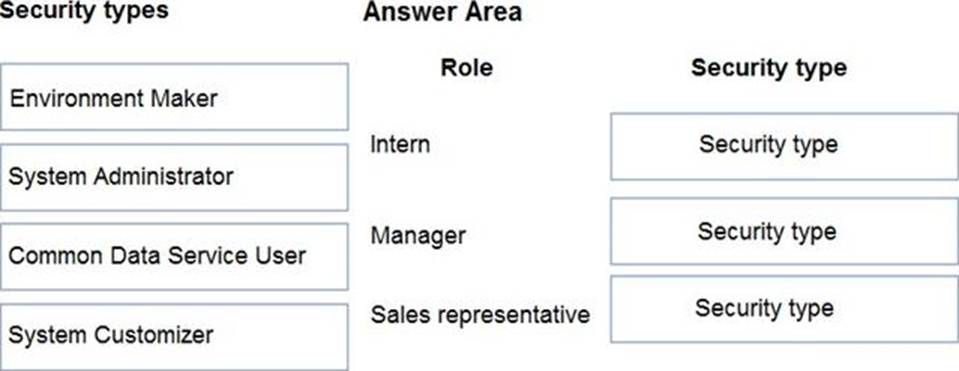
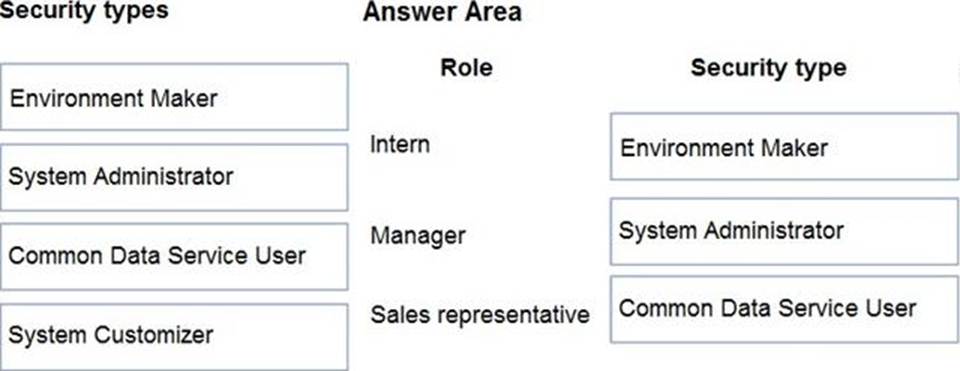
Explanation:
Scenario: The company identifies the following job roles:

You must grant users the minimum permissions required to perform their job tasks.
Intern: Environment Maker
Environment Maker: Can create new resources associated with an environment, including apps, connections, custom APIs, gateways, and flows using Microsoft Power Automate. However, this role doesn’t have any privileges to access data within an environment.
Manager: System Administrator:
System Administrator: Has full permission to customize or administer the environment, including
creating, modifying, and assigning security roles. Can view all data in the environment.
Sales representative: Common Data Service User
Basic User/ Common Data Service User: Read (self), Create (self), Write (self), Delete (self)
Can run an app within the environment and perform common tasks for the records that they own.
HOTSPOT
You are creating an application using the Microsoft Dataverse SDK for .NET.
A record must be created by using the column types of lookup and choices.
You need to set the record’s column values.
Which attribute type should you use? To answer, select the appropriate options in the answer area. NOTE: Each correct selection is worth one point.
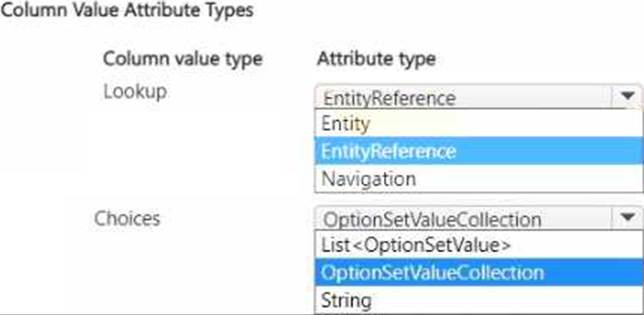
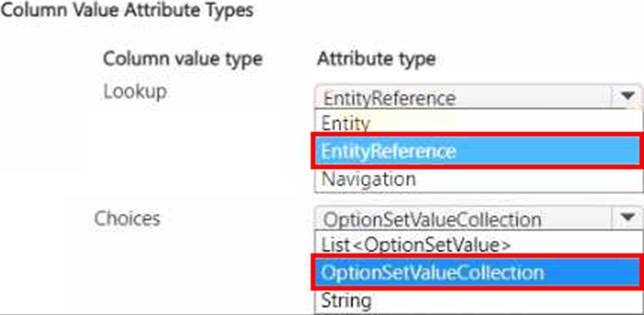
HOTSPOT
You work for a multinational company that has Azure and Common Data Service environment in the United States (UTC-7) and Japan (UTC+9).
You create Azure Functions for each location to update key data.
You need to configure the functions to run at 4:00 AM on weekdays at each location.
Which schedule formats should you use? To answer, select the appropriate options in the answer area. NOTE: Each correct selection is worth one point.
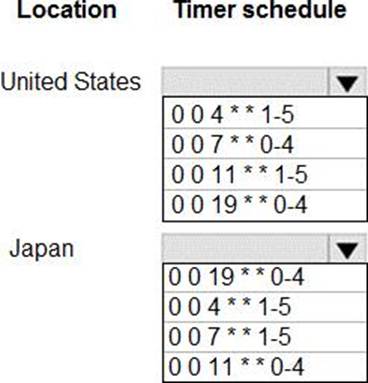
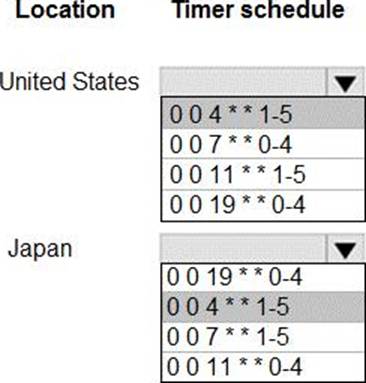
Explanation:
Box 1: 0 0 4 * * 1-5
Azure Functions uses the NCronTab library to interpret NCRONTAB expressions.
An NCRONTAB expression is similar to a CRON expression except that it includes an additional sixth field at the beginning to use for time precision in seconds:
{second} {minute} {hour} {day} {month} {day-of-week}
NCRONTAB time zones
The numbers in a CRON expression refer to a time and date, not a time span. For example, a 5 in the hour field refers to 5:00 AM, not every 5 hours.
The default time zone used with the CRON expressions is Coordinated Universal Time (UTC).
To have your CRON expression based on another time zone, create an app setting for your function app named WEBSITE_TIME_ZONE.
1-5 is weekdays
Box 2: 0 0 4 * * 1-5
Reference: https://docs.microsoft.com/en-us/azure/azure-functions/functions-bindings-timer?
